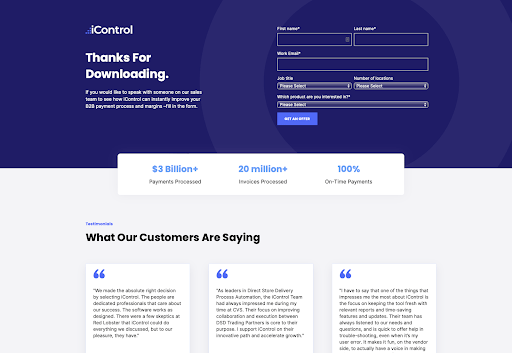A question I hear far too often from content marketers. And for good reason. Content is a marathon, not a sprint. Your typical content marketer will measure leading indicators, and may challenge the notion of MQLs or SALs attributed to content.
Content is everywhere. It’s beyond just white papers, blogs, and ebooks –it’s also the website copy, or the images utilized to drive conversion. This is typically what causes confusion and uncertainty for content marketers –how do you measure the success of good copy on the website, or conversions from articles? The crucial aspect here is to define a set baseline, and stick with it. Measuring apples to apples.
It is also important to align across all teams on the definition of an MQL. Most consider them “hand raisers who want to hop on a sales conversation” but there are many other ways to define it too. To learn more on how to define an MQL, read our blog.
Below are 10 options to get you started on correctly attributing MQLs or SALs to content.
1. Last page viewed before conversion
This is the best place to start. After an MQL comes through, consider going into your CRM to see what were the pages viewed before they ultimately converted. Was it a blog? A Resource download? Perhaps it was a long-form thought leadership piece. As mentioned above, it is important to ensure you set the appropriate definition, and stick with it! For example – if we’re counting blogs today, we can’t not count them later on.
Most CRMs today can build dashboards based on this alone. Consider setting up campaigns, or tags that will help make tracking –and your life –a lot easier.
2. In-line CTA clicks
Have you properly optimized your blogs for conversion? The best content marketers don’t just add CTAs at the end of blogs, they add it throughout. Consider adding lead magnets like checklists, infographics, videos, or any downloadables to help drive conversions. You can now track the downloads per contact, and when they convert to an MQL, you can view their entire journey.
Again, automation here is your best friend. Don’t waste calories manually tracking these.
3. Resource downloads that pass lead scoring
If you have a robust lead scoring system that is able to track activities a contact takes on your website –consider using this as a measure. Define the threshold of an MQL based on the content available, and let your automation do the heavy lifting. For example –One could define an MQL as 3 Ebooks Downloaded, as it shows a high purchasing intent. Add the activity to your lead scoring model, and watch the MQLs grow.
You can learn more about setting up a robust lead scoring model for your B2B SaaS company in our blog.
4. “Thank you page” conversions
Often missed, a “Thank You” page is one of the most effective ways to measure MQLs from content, but also drive tremendous conversion. This is the page that prospects see after they hit the download button. On the page, add an MQL / Request-a-demo form to capture them while they’re hot! Those captured will then be considered content MQLs as they’ve just come from the piece of content. Example of a thank you page below.

5. Email nurture clicks
Let’s start with the “easy” method. Did an MQL convert after clicking a CTA in a nurture email or newsletter? Fairly straightforward. However, oftentimes marketing teams are banking on them converting from one measly button. The reality of the situation is that MQLs hardly ever come from newsletters. They need to be nurtured constantly, and will likely convert after consuming content on the website instead.
But let's not let those clicks go to waste! Consider adding them into the lead scoring model as well –this will incentivize marketing teams to create better, and more nurture sequences; supercharging the likelihood of passing the lead scoring system.
Learn more about effective B2B SaaS lead nurturing through targeted content in our blog.
6. Pop-up downloads
Does your piece of content have an exit-intent, or time-based pop-up to drive conversions? While some marketers may feel uncomfortable and pushy adding in-line CTAs to articles, this is an easy way to still drive conversion. Now you can use the form as a measure as you know exactly which page they converted on.
| Pro tip: Consider the stage of the piece of content and use the pop-up to nurture your lead. For example –If your article is for awareness, you don’t want a pop-up to be “get a demo”, but likely “download our eBook”. And only after downloading the eBook, a pop-up appears prompting “get-a-demo”. Slow and steady wins the race. |
7. Live chat/chatbot messages
Similar to the pop-up, Live chat or chatbots are a great way to capture someone mid-content consumption –without turning your content into a pushy sales piece. And similar to above, consider the buyer journey and stage of your piece of content. Maybe the chatbot message starts with “Enjoying the read? If you’d like to see more I can help you find great resources.” Then, let lead scoring take it the rest of the way.
8. Post-video CTAs
In 2022, gated content can sometimes work against you. When video creation has become so accessible, consumers today can take their attention elsewhere when videos are gated. Fortunately, modern video streaming platforms allow for forms to be added post video. After a video ends, you should prompt the viewer for their information. Take those form captures, and count them.
9. In-video CTAs
Alternatively, having in-video CTAs can be effective –assuming you work it beautifully into the content, and it doesn't feel forced. Consider setting up a unique tracking link/campaign for the video –then referring to it in the video itself. This will help you easily identify and measure where the MQL source came from.
| Pro tip: It can often be difficult to elegantly work a CTA mid-video. Consumers today are very sensitive to this. Consider addressing it head-on, and being genuine. While seemingly counterintuitive, viewers are always seeking a trusted guide to help them find the right solution. |
10. Gated lead magnet forms
Finally, there will always be a time and place for gated content –it’s a classic. The most effective way to do it like the movie industry –offer a ‘trailer’. Create a compelling piece that feeds into their hunger to read on. And while the gate often does not constitute an MQL, the practices learned above will help drive them to MQL.
When properly defined, aligned, and measured –content can become the most important function within your marketing department. It is the backbone of the majority of marketing activities, meaning it is equally crucial to attribute MQLs to content correctly.
To see more blogs on content marketing feel free to read more on our Kalungi Blog.
Boost awareness, kickstart organic growth, and get content marketing support for every stage of your marketing funnel. Leverage our team of specialists and a custom GTM strategy to start seeing impactful results.
Get started
